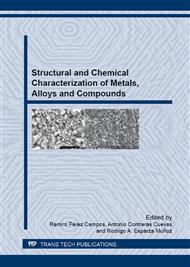[1]
F. Trifiro, A. Vaccari, Hydrotalcite-like anionic clays double hydroxides), in: J.L. Atwood, J.E.D. Davies, MacNicol, F. Vgtle (Eds. ), Comprehensive Supramolecular Chemistry, vol. 7, Pergamon, Oxford, 1996, p.251.
Google Scholar
[2]
T. Cavani, E. Trifiro and E.A. Vaccari, Hydrotalcite-type anionic clays: Preparation, properties and applications, Catalysis Today 2 (1991) 173-301.
DOI: 10.1016/0920-5861(91)80068-k
Google Scholar
[3]
H. F.W. Taylor, Crystal Structures of Some Double Hydroxide Minerals, Miner. Mag. 39 (1973) 377-389.
DOI: 10.1180/minmag.1973.039.304.01
Google Scholar
[4]
J.S. Raisman and A.M. González: Impacto de los residuos de las tenerías sobre el medio ambiente y la salud humana (Hipertextos del Área de la Biología 2004).
DOI: 10.25062/9786280000701.04
Google Scholar
[5]
J.S. Raisman and A.M. González: Curtido Al Cromo (Hipertextos del Área de la Biología 2004).
Google Scholar
[6]
IARC: Monograph on the Evaluation of Carcinogenic Risk to Humans, Chromium, Nickel and Welding, Lyon, France (1990).
Google Scholar
[7]
R.A. Anderson, Nutritional role of chromium, Sci. Total Environ 17 (1981) 13-29.
Google Scholar
[8]
L. Fishbein, Sources, transport and alterations of metal compounds: an overview. I. Arsenic, beryllium, cadmium, chromium and nickel, Environ. Health Perspect 40 (1981) 43-64.
DOI: 10.1289/ehp.814043
Google Scholar
[9]
P.H.S. US Department of Health and Human Services: Toxicological Profile for Chromium, (2000).
Google Scholar
[10]
G.X. Pan, Z.M. Ni, C.P. Fang, L.G. Wang and J.B. Chen, ZnA1 hidrotalcita adsorción estudio de rendimiento de Cr (VI), Journal of Zhejiang University of Technology 33 (2005) 334-336.
Google Scholar
[11]
S.S. Baral, S.N. Das, P. Rath, G.R. Chaudhury and R. Gautam, Chromium(VI) removal by calcined bauxite, J. Bio. Chem. Eng. 34 (2007) 69-75.
DOI: 10.1016/j.bej.2006.11.019
Google Scholar
[12]
Q.L. Wan, Q.S. Wang, Q.Z. Huang, S.M. Wang, Treatment of chromium(VI) in water by bentonite-chitosan compound adsorbent, Industrial Water and Wastewater 37 (2006) 44-47.
Google Scholar
[13]
J.Y. Park, W.H. Kang and I. Hwang, Hexavalent chromium uptake and release in cement pastes, Env. Eng. Sci. 23 (2006) 133-140.
DOI: 10.1089/ees.2006.23.133
Google Scholar
[14]
E. Alvarez-Ayuso, A. García-Sánchez and X. Querol, Adsorption of Cr(VI) from synthetic solutions and electroplating wastewaters on amorphous aluminium oxide, J. Hazard. Mater. 142 (2007) 191-198.
DOI: 10.1016/j.jhazmat.2006.08.004
Google Scholar
[15]
Y.C. Sharma and C.H. Weng, Removal of chromium(VI) from water and wastewater by using riverbed sand: Kinetic and equilibrium studies, J. Hazard. Mat. 142 (2007) 449-454.
DOI: 10.1016/j.jhazmat.2007.04.014
Google Scholar
[16]
S.J. Xia, Z.M. Ni, G.X. Pan and L. G. Wang, Study of adsorption of Cr(VI) from aqueous solutions on Co/Mg/Al-layered double hydroxides, Journal of Zhejiang University of Technology 34 (2006) 517-520.
Google Scholar
[17]
K. Nakamoto: Infrared and Raman Spectra of Inorganic and Coordination Compounds, (A Wiley – Interscience Publication 1986).
Google Scholar
[18]
M. J. Hernandez-Moreno, M. A. Ulibarri, J.L. Rendon, and C. J. Serna, IR characteristics of hydrotalcite-like compounds, Phys. Chem. Minerals 12 (1985) 34-38.
Google Scholar
[19]
M. Bolognini, F. Cavani, D. Scagliarini, C. Flego, C. Perego and M. Saba, Mg/Al mixed oxides prepared by coprecipitation and sol–gel routes: a comparison of their physico-chemical features and performances in m-cresol methylation, Micro. Meso. Mater. 66 (2003).
DOI: 10.1016/j.micromeso.2003.09.010
Google Scholar
[20]
T. W. Weber and R. K. Chakraborty, Pore and solid diffussion models for fixed bed adsorbents, J. Am. Inst. Chem. Eng. 20 (1974) 2228-2238.
Google Scholar
[21]
N. Ahalya, R.D. Kanamadi and T.V. Ramachandra, Biosorption of chromium (VI) from aqueous solutions by the husk of Bengal gram (Cicer arientinum), Electron. J. Biotechnol. 8 (2005) 258-264.
DOI: 10.2225/vol8-issue3-fulltext-10
Google Scholar


